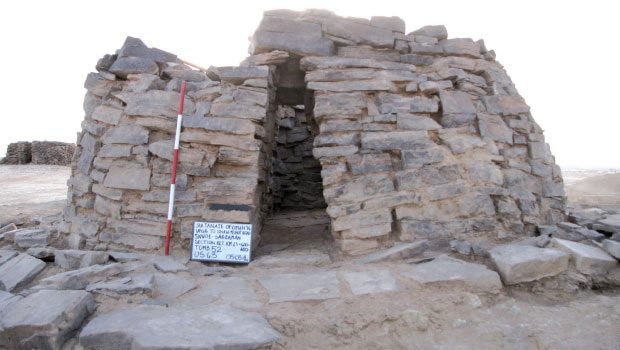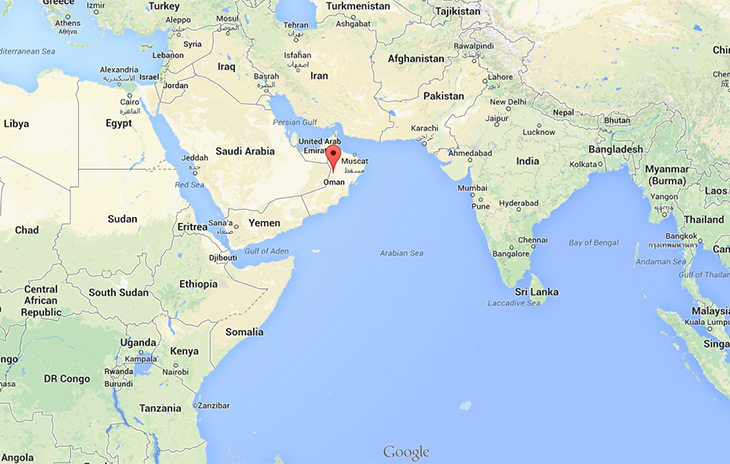
Archaeologists have unearthed a site near Sinaw that could reveal India’s ancient Indus Valley civilisation’s far reaching influence on the Omani society thousands of years ago, according to officials of the Ministry of Heritage and Culture. During an excavation, archaeologists have found a tomb from 2,300 years ago of a man who was buried with sword and daggers made of iron and steel from the Indus Valley civilisation. It has been scientifically proven that iron and steel arms were first made in the Indus Valley civilisation.
Sultan Bensaif Al Bakri, director of Excavations and Archaeological Studies of the Ministry of Heritage and Culture has said that this finding may prove the influence of the Indian civilisation on Oman during that period. However, he said that further studies would be carried out on this regard.
Al Bakri has said that a 2,300 year-old underground chamber was found during excavations 22 km south of Sinaw. This was the burial chamber of a man in his 50’s, buried along with his personal arms. Near his grave, two male and female camels were also buried. They were slaughtered after the death of the man. The walls of the graves of these camels were erected with stones.

He said that the man was buried separately, on the right side of the camels’ graves, with his 88cm sword in front of him. In addition, two daggers were tied on the right and left sides of his waist. A robe and woolen cap was also buried along with him. According to the descriptions provided by the archaeologists, the sword and daggers were made of iron and steel which was first made in the Indian civilisation from where it spread to the neighbouring civilisations, including Oman, said Al Bakri.
He said that the sword was kept in front of the man as the handle of the sword was facing him. Its handle was partly covered with textured ivory shaped like an eagle’s beak. It is believed that the man was a chieftain of a tribe, as is evident from the sword and the robe. He was buried as his head was on a pillow and his hat was kept near his head. He was wearing leather shoes.
The Ministry of Heritage and Culture will restore these arms and will display these models in the proposed national museum scheduled to open at the end of this year.
This finding was made during an excavation carried out by the Ministry of Heritage and Culture in coordination with the ministry of transport and communications that was working on the project of Sinaw-Mahout-Duqm road.
While digging, the Ministry of Transport and Communications found a graveyard spread across 100 sq m. This major archaeological finding was made when the ministry excavated 35 graves that came in the way of the proposed road. Archaeologists have concluded that these graves were of two different periods. One is of third century BC while the second is of the first century BC, which included various tombs, potteries and utensils.















This influence reached as far as Jordan, maybe further. A man from Jordan said that they had in the ancient past won many wars with swords made from Indian steel!
Good information. It has proved again about our ancient cultural heritage. Pats for archaeologists.
Thanks for the article, more evidence that the historical “Narrative” of Eastern culture set down by 1800s British “archaeologists” is crumbling into the dust. Where it belongs.
When discussing “modern humans,” the “East vs West” development of culture/civilization is a false paradigm: it was the SAME ONE. The “west” was settled by the east.
2300 years ago was long after the Indus valley had spread their agri-culture to back down to the M.E. As in 2500-3000 years later. He was buried with camels. They have a set date they were domesticated. It is long after proof of Vedic Hindu culture in this region. Thousands of years in fact.
This man may have been a chietain, and Vedic Hindu, but he certainly was no early pioneer. He may also have very well acquired those iron implements in trade from India or Anatolia.
Regardless of what “scholars” tell us, common sense indicates children playing in water find something to float on, even if it is just a log….surely “modern human” adults 130,000 years ago could build ships to travel in. They have just decayed and disappeared now. Just “hugging the coast” one can travel quite quickly from Jordan to southern India. Trading goods the entire way.
Jordan is in the path of the migrating “modern humans” leaving south Africa and moving north into the Arabian Peninsula, west into Egypt and east to southern India.
This would have started at least 130,000 years ago.
The Indus Valley culture collapsed around the Sarisvati river area by 1800 BC from severe drought, over 3800 years ago. So this burial in Jordan came 1500+ years after Indus valley collapsed.
I know there is evidence of Vedic/Hindu culture in Greece 4000 years ago. I know where archaeologists found a Shiva’s Linga in a tomb in Greece, and the king’s name was very close to Yayati. “Alyates.” al-Yati.
I know there is evidence of Vedic Hindu culture in Egypt, circa 4600 years ago. I have tons of evidence there. It is so obvious, one wonders if “Egyptologists” are all conmen?
I know there is evidence of Vedic Hindu culture in Georgia, at Colchis, where the king’s name was “Aates.” (Yayati).
I know there is evidence of Vedic Hindu culture in Mexico. I know there is evidence of Vedic Hindu culture in Peru. I know there is evidence of Vedic Hindu culture in “Minoan” Crete.
I know this, and can easily prove it.
Defining what is “human” may be the start: there was found a 65,000 year old coastal burial site in Philippines 2-3 years ago, of what was described as a “hominem” buried alongside his boat.
His boat. A “hominem.”
So, if Hindu records show Dwarka being 70,000 years old….that actually seems quite the reasonable timeline, taking recent scientific DNA and archaeological evidence into consideration.
BTW: Hindu worshipers/farmers carried that iron working trade to Anatolia and Thailand.
To the east:Thailand also had an 1800 BC iron smelting culture, in Udon Thani. Vedic Hindus. The Chedi tribe. The Kasi tribe. Neighbors in India, yes?
Anatolia to the west: The Khabur river area. They are the ones that forged
“King Arthur’s” sword, “Excaliber.” Arthur was not “British.” He was an actual king, murdered by “Uther.” That should be a name that “rings a bell” with Hindu scholars…if they “listen closely.”
I can prove that, and can show photo of that sword.
“Arthur’s” niece, Satyavati, wife of Santanu, gave it to her grandson. He was found buried with it on his chest.
And that is how I can prove Vedic Hindus built the “Great Pyramid” to honor Shiva.
The “Mountain” ancient Egyptians called MERU.
Hint: The “Meidum pyramid”….that was no pyramid. That was a huge Shiva’s Linga.
How can one fill in the blanks in between 70000 year old Dwarka ( A 65,000 year old coastal burial site in Philippines where a “hominem” fouund buried alongside his boat ) and Indus valley civilization about 5000 years ago, and can link both and in between records as ancestors of Vedic Hindus.
Farang ypu seem to know a lot we dont.can u share these articles for our better understanding ?
Beautiful information, breath taking………….
Farang you do write well, keep giving us some more light into this fantastic reading. I do want to know more, nothing seems to be enough.
The entire planet practiced Sanathana Dharma .There was no other religion that exsisted. Aryans came to India are just cock and Bull history.British changed the history of India despite resistance from many global historians. Where ever you drop a coin on this planet you will find the Trace’s of Sanathana Dharma. Shiva Lingas particularly as shiva is form less and was worshipped every where similarly is Vishnu. When Brahminical values practices traditions started diluting over few centuries confusion took position. Parents were unable to answer basic questions asked by their own children. They would only say you should not ask such questions because of their own ignorece. Let’s all pray hope Sanathana Dharma comes in to practice every where. That will heal the planet and its inhabitants Venkatesh
Can you please enlighten me as to how Bharatvarsha got renamed as Hindustan and the cultural philosophy Christendom as Hindu religion, are we not mimicking some one who coined these words ? Great full if an explanation is available.
Farang you should share more of this information..you must…write a small article on this website…please..
Yes Farang.
Thank you Farang for the wonderful read and the information.
I enjoyed every bit of it.